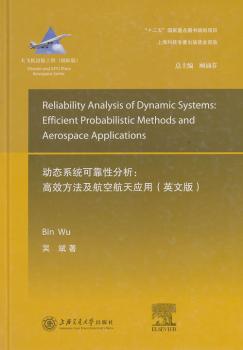内容简介
《动态系统可靠性分析--方法及航空航天 应用(英文版)(精)/大飞机出版工程》编著者吴 斌。
《动态系统可靠性分析--方法及航空航天 应用(英文版)(精)/大飞机出版工程》针对动态 系统的可靠性分析,阐述了一种新的优化技术,即针 对低频率谐 振动力载荷下的工程产品结构可靠性问题,使用综合 的快速概率方法,也即“扰动 算法+蒙特卡洛方法”。在针对两个航空航天实际工 程案例的应用中发现,运用此 方法能快速准确地解决失效面高非线性、大量计算强 度和动态系统高复杂度等原 有概率方法的应用困难。本书的出版填补了上对 快速概率方法的研究空 白。
本书可供从事民用飞机结构可靠性安全性工程设 计分析、试验、管理的技术人 员和相关专业的研究生使用。
目录
目录
Dedication
Preface
Acknowledgments
Nomenclature
List of Figures
List of Tables
1.Introduction
1.1 Structural Reliability Analysis
1.2 Non-deterministic Reliability Analysis Methods
1.2.1 Monte Carlo Simulation (MCS) Method
1.2.2 FORM (First-order Reliability Method)
1.2.3 Interval Analysis
1.2.4 Fuzzy Analysis
1.2.5 Response Surface Method (RSM)
1.2.6 Summary
1.3 Uncertainty Analysis of Dynamic Systems
1.3.1 Background
1.3.2 Literature Review of Analytical Approaches to Dynamic Systems
1.3.3 Summary
1.4 Scope of the Present Work
1.5 Overview of the Book
2.Technical Background
2.1 Definition of Structural Reliability
2.2 Technical Basis of the Monte Carlo Simulation Method
2.3 Theory of the First-order Reliability Method (FORM)
2.4 Response Surface Method
2.4.1 Response Surface Models and Fitting Techniques
2.4.2 Sampling Design Methods
2.5 Problems of Applying FORM and RSM Methods to Dynamic Systems
2.5.1 Problematic Failure Surfaces for FORM Applications
2.5.2 Inaccuracy of RSM in Predicting the Dynamic Response
2.6 Optimization Solution Through Modal Analysis
3.Theoretical Fundamentals of the Perturbation Approach
3.1 Definition of the New Parameters and Safety Margin
3.2 Derivation of the Two Moments of the New Parameters
3.2.1 Derivation of the Covariance Matrix of the Modal Parameter w2
3.2.2 Derivation of the Covariance Matrix of the Defined Parameter dr
3.2.3 Derivation of the Covariance Matrix of the Modal Parameter [□]
3.2.4 Derivation of the Covariance Matrix of the Defined Parameter rjk,r
3.2.5 Derivation of the Covariance Matrix of the Combined Parameter T
3.2.6 Derivation of the Mean Values of the Defined Parameters dr and rik,r
3.3 Application Procedure of the New Approach
3.4 Discussion
3.5 Summary
4.Application to a 2D System
4.1 Finite Element Model of a 2D Dynamic System
4.2 Applying the Combined Approach: Preliminary Analysis
4.2.1 Response Analysis
4.2.2 Safety Margin Contour
4.3 Perturbation Approach + FORM Method
4.3.1 evaluating the Probability of Failure and In-depth Analysis
4.3.2 Solution 1: Second-order Approximation of d2
4.3.3 Solution 2: New Variable e2 to Replace d2
4.3.4 Solution 3: Variable □ to Replace e2
4.4 Solution 4: Monte Carlo Simulation Replacing FORM
4.4.1 Perturbation + Monte Carlo Simulation on r2 and w□
4.4.2 Reliability Analysis




 VIP会员
VIP会员